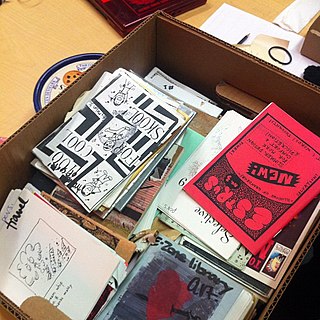
A zine is a small-circulation self-published work of original or appropriated texts and images, usually reproduced via a copy machine. Zines are the product of either a single person or of a very small group, and are popularly photocopied into physical prints for circulation. A fanzine is a non-professional and non-official publication produced by enthusiasts of a particular cultural phenomenon for the pleasure of others who share their interest. The term was coined in an October 1940 science fiction fanzine by Russ Chauvenet and popularized within science fiction fandom, entering the Oxford English Dictionary in 1949.
Queercore is a cultural/social movement that began in the mid-1980s as an offshoot of the punk subculture and a music genre that comes from punk rock. It is distinguished by its discontent with society in general, and specifically society's disapproval of the LGBT community. Queercore expresses itself in a DIY style through magazines, music, writing and film.

A punk zine is a zine related to the punk subculture and hardcore punk music genre. Often primitively or casually produced, they feature punk literature, such as social commentary, punk poetry, news, gossip, music reviews and articles about punk rock bands or regional punk scenes.

Bruce LaBruce is a Canadian artist, writer, filmmaker, photographer, and underground director based in Toronto.

Thomas Daniel Jennings is a Los Angeles-based artist and computer programmer, known for his work that led to FidoNet, and for his work at Phoenix Software on MS-DOS integration and interoperability.
Fifth Column was a Canadian all-female post-punk band from Toronto, formed in 1980 and breaking up in 1995.
A gay skinhead, also known as a gayskin or queerskin, is a gay person who identifies with the skinhead subculture. Some gay skinheads have a sexual fetish for skinhead clothing styles.
Chainsaw Records is an independent record label run by Donna Dresch that is devoted to Queercore bands. The label is in Portland, Oregon.
Outpunk enjoys the distinction of being the first record label entirely devoted to queer punk bands.
Tony Arena, also known by his pen name Anonymous Boy, is an openly queer artist, writer, and filmmaker. He is known for his comics, his involvement in the queercore movement, and other contributions to queer punk zines, his column in Maximum Rocknroll magazine, his public-access television program The Wild Record Collection, and animation such as his film Green Pubes.

No Skin Off My Ass is a 1991 comedy-drama film by Bruce LaBruce.
Donna Dresch is an American punk rock musician, perhaps best known as founder, guitarist and bass guitarist of Team Dresch.
Fanorama is a Rhode Island-based zine and zine-distro produced by journalist/activist REB. According to their website it is the "grand-daddy of the queer zine scene".
Leslie Mah is an American musician and performer.

She-Devils is an Argentine punk group that started 1995. The band has often been associated with the homocore and Queercore genres.
Daniel "Deke" Frontino Elash is an American zine editor, musician, actor, activist and historian.

Homocore was an American anarcho-punk zine created by Tom Jennings and Deke Nihilson, and published in San Francisco from 1988 to 1991. One of the first queer zines, Homocore was directed toward the hardcore punk youth of the gay underground. The publication has been noted for popularizing the queercore movement on the United States west coast.
G. B. Jones is a Canadian artist, filmmaker, musician, and publisher of zines. She is best known for producing J.D.s and her Tom Girls drawings.
William Grant Munro was a Toronto artist, club promoter, and restaurateur known for his work as a community builder among disparate Toronto groups. As a visual artist, he was known for fashioning artistic works out of underwear; as a club promoter, he was best known for his long-running Toronto queer club night, Vazaleen.
Fagatron was a short-lived but influential punk rock band in the Queercore movement which gained a small cult following for its emphasis on radical politics and queer identity. It was formed in 1996 by Abe Miner and Jeromy Ogg of Lincoln, Nebraska.







